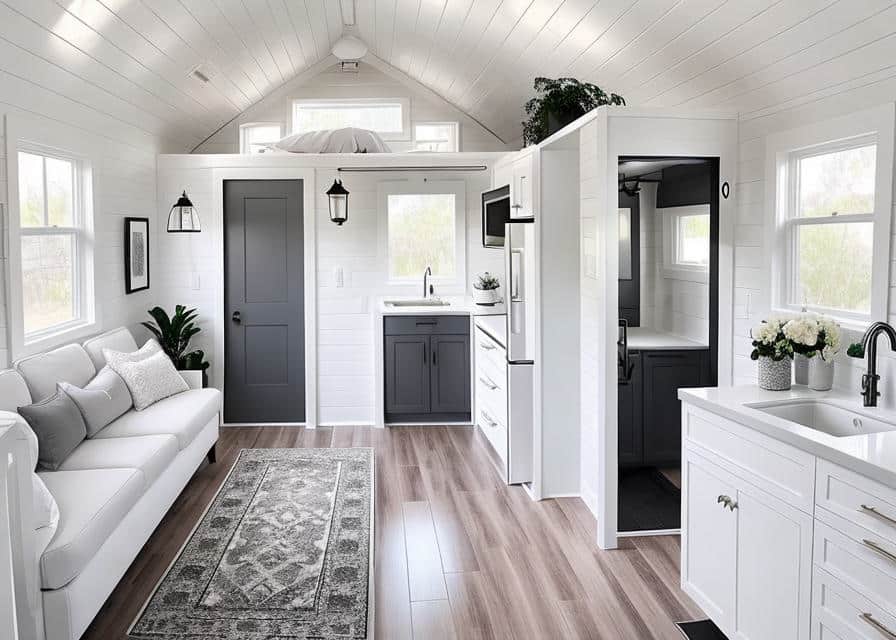Table of Contents
- Introduction
- What is a Tiny House?
- Types of Tiny Houses
- Benefits of Tiny Houses
- Drawbacks of Tiny Houses
Introduction
This article provides helpful advice on how to manage a tiny house Airbnb investment. Tiny houses are becoming increasingly popular as a sustainable and cost-effective option for hosting, and this article will provide guidance on how to successfully manage your tiny house Airbnb investment. This includes registering the property with local government, researching what other successful hosts have done, getting insurance, providing a thorough description of the home, and automating responsibilities using Host Tools.
What is a Tiny House?
A tiny house is a small, usually mobile dwelling that typically ranges from 100 to 400 square feet. The idea of living in a tiny house has become popular in recent years as people seek to downsize their lifestyles and become more environmentally conscious. Tiny houses are often built on trailers, which makes them easy to transport, and some models can even be towed behind cars or trucks. They are also relatively inexpensive compared to traditional homes, making them an attractive option for those looking for affordable housing.
Types of Tiny Houses
Tiny houses come in all shapes and sizes, from cozy cabins to modern-style dwellings. Some feature lofted bedrooms that maximize space, while others have full-sized kitchens and bathrooms with showers and sinks. many tiny houses are designed to be off-grid, meaning they don’t rely on traditional utilities like electricity or water. This makes them ideal for those who want to live sustainably without sacrificing comfort.
Benefits of Tiny Houses
tiny houses offer many benefits over traditional homes, including lower costs and greater mobility. They require less energy to maintain than larger homes because they have fewer appliances and smaller spaces that require heating or cooling. Additionally, they take up less land than a traditional home would, making them a great option for those who want to live close to nature without sacrificing the comforts of home. Finally, tiny houses provide an opportunity for homeowners to make money by renting out their homes as Airbnb investments.
Drawbacks of Tiny Houses
While there are many advantages to living in a tiny house, there are some drawbacks as well. For example, since they are much smaller than traditional homes, it can be difficult to find furniture that fits comfortably inside the home’s limited space. Additionally, due to their size, tiny houses may not be suitable for large families or those who need extra storage space for items like tools or sports equipment.
Overall, tiny houses offer an affordable and sustainable alternative to traditional housing options while providing the opportunity for homeowners to make money through Airbnb investments. With proper planning and research, anyone can successfully manage a tiny house Airbnb investment and reap the rewards of this unique form of real estate investing!
|
Tiny House
|
Description
|
|
Size
|
100-400 square feet
|
|
Mobility
|
Can be towed behind cars or trucks
|
|
Cost
|
Relatively inexpensive compared to traditional homes
|
|
Types
|
Cabins, modern-style dwellings, off-grid options, etc.
|
|
Benefits
|
Lower costs, greater mobility, less energy to maintain, etc.
|
|
Drawbacks
|
Limited space for furniture and storage items, not suitable for large families, etc.
|
Why Make a Tiny House Airbnb Investment?
Tiny houses are becoming increasingly popular as an investment option for those looking to rent out their properties on Airbnb or other short-term rental sites. With the rise of sustainable living, tiny houses are a great way to reduce one’s carbon footprint and save money on utilities and maintenance costs.
Tiny houses offer a variety of benefits for potential investors. They are small enough to be placed in urban areas, but large enough to provide comfortable living space for guests. Additionally, they can often be built with recycled materials, making them an environmentally friendly choice. Furthermore, they require minimal upkeep and can be easily moved if needed.
For those looking to make a return on their investment, tiny house airbnb rentals are a great option. They have low overhead costs and allow investors to charge competitive rates without sacrificing quality or comfort. Additionally, many cities have taken steps to make renting out tiny houses easier by providing incentives such as tax breaks or reduced fees.
Investors should also consider the potential risks associated with investing in tiny house airbnbs. These include local ordinances that may limit the number of days that a property can be rented out or impose restrictions on who can stay there. Additionally, it is important to research the local market and determine whether there is sufficient demand for your property before investing in it. Finally, it is important to consider how you will manage the property once it is rented out; this includes ensuring that it meets safety standards and taking care of any necessary repairs or maintenance tasks.
Overall, investing in a tiny house Airbnb can be a great way to generate income while helping the environment and providing guests with an enjoyable experience. With proper research and planning, investors can maximize their returns while minimizing their risks associated with this type of investment.
|
Benefit
|
Description
|
|
Size
|
Small enough to be placed in urban areas but large enough to provide comfortable living space for guests
|
|
Environmental
|
Can often be built with recycled materials, making them an environmentally friendly choice
|
|
Upkeep & Cost Savings
|
Require minimal upkeep and can be easily moved if needed
|
|
Return on Investment
|
Low overhead costs and competitive rates without sacrificing quality or comfort
|
|
Incentives
|
Many cities have taken steps to make renting out tiny houses easier by providing incentives such as tax breaks or reduced fees
|
How to Successfully Manage a Tiny House Airbnb Investment
Making an Airbnb investment in a tiny house is a great way to make money while helping the environment. But, like any other property investment, it requires careful management to be successful. Here are five tips on how to manage your tiny house Airbnb investment:
1. Register with Local Government
The first step in managing a tiny house Airbnb investment is to register the property with local government. This will ensure that you are compliant with all relevant laws and regulations, and that you have the necessary permits for renting out the property. It’s also important to understand what taxes you will need to pay as an Airbnb host in your area. This information can usually be found on your local government’s website or by contacting them directly.
2. Research What Other Successful Hosts Have Done
It’s always a good idea to research what other successful hosts have done before embarking on an Airbnb investment journey of your own. Check out reviews of top-rated hosts in your area, and take note of their strategies for pricing, marketing, and customer service. You can also join online communities dedicated to sharing information about successful hosting strategies and best practices.
3. Get Insurance
Insurance is essential when it comes to protecting yourself and your tiny house airbnb investment from potential damages or losses due to accidents or natural disasters. Make sure you get insurance coverage for both the structure of the home itself as well as its contents such as furniture and appliances. Additionally, consider getting liability insurance in case someone gets hurt while staying at your tiny house rental property.
4. Provide a Thorough Description of the Home
When listing your tiny house on Airbnb, make sure you provide a thorough description of its features and amenities so that potential guests can easily decide if it’s right for them or not. Include details about size, layout, furnishings, appliances, outdoor space, etc., as well as photos that accurately represent the home’s condition and style. Also include information about nearby attractions and activities so guests know what they can do during their stay at your property.
5 Automate Responsibilities Using Host Tools
Finally, automate some of your responsibilities using host tools such as automated messages that remind guests about check-in times or cleaning services that come to clean up after each guest leaves so you don’t have to worry about it yourself. These tools can help streamline processes and save time so that you can focus more on providing excellent customer service to ensure positive reviews from guests which will help boost bookings for future stays at your tiny house airbnb investment property!
Main Idea: Careful management is essential for successful tiny house airbnb investment, including registration, researching strategies, insurance, thorough descriptions and automation.
Automate Your Tiny House with Host Tools
Automation is a great way to manage your tiny house Airbnb investment. There are many host tools available that can help you streamline your hosting duties and reduce the amount of time you spend on administrative tasks. Here are some tips for automating your tiny house Airbnb:
1. Get the Right Software
The right software can make all the difference when it comes to managing your tiny house Airbnb investment. Look for software that can help you automate tasks such as scheduling, messaging guests, and tracking payments. You may also want to consider software that allows you to manage multiple properties from one dashboard. This will save you time and energy in the long run.
2. Automate Messaging
Messaging guests can be a time-consuming task, but it’s an important part of being a successful host. Automating messages can help you save time and ensure that your guests receive timely responses. Look for software that allows you to create automated messages for common requests or questions. You may also want to consider setting up an automated response system so that guests can get answers quickly even if you’re not available.
3. Streamline Payments
Payment processing is another important part of managing a tiny house Airbnb investment, and automation can make this process much easier. Look for software that allows you to set up automatic payments so that guests can pay quickly and easily without any hassle on your end. You may also want to look into setting up payment reminders so that guests don’t forget to pay their bills on time.
4. Monitor Performance
Finally, look for software that allows you to monitor the performance of your tiny house Airbnb investment over time. This will help you identify areas where you need improvement and make adjustments as needed in order to maximize your profits and keep guests happy. Automated performance monitoring tools will help you stay on top of changes in the market and ensure that your tiny house Airbnb remains profitable in the long run.
Automation is a great way to simplify the process of managing a tiny house Airbnb investment, saving you both time and energy in the long run. By taking advantage of host tools, you can streamline administrative tasks such as messaging, payments, and performance monitoring so that running your tiny house Airbnb is less stressful and more profitable than ever before!
Conclusion
Tiny houses are a great way to invest in Airbnb hosting. By following the tips outlined in this article, you can successfully manage your tiny house Airbnb investment. Register the property with local government, research what other successful hosts have done, get insurance, provide a thorough description of the home, and automate responsibilities using Host Tools. With proper management, your tiny house Airbnb investment can be a sustainable and cost-effective option for hosting.


